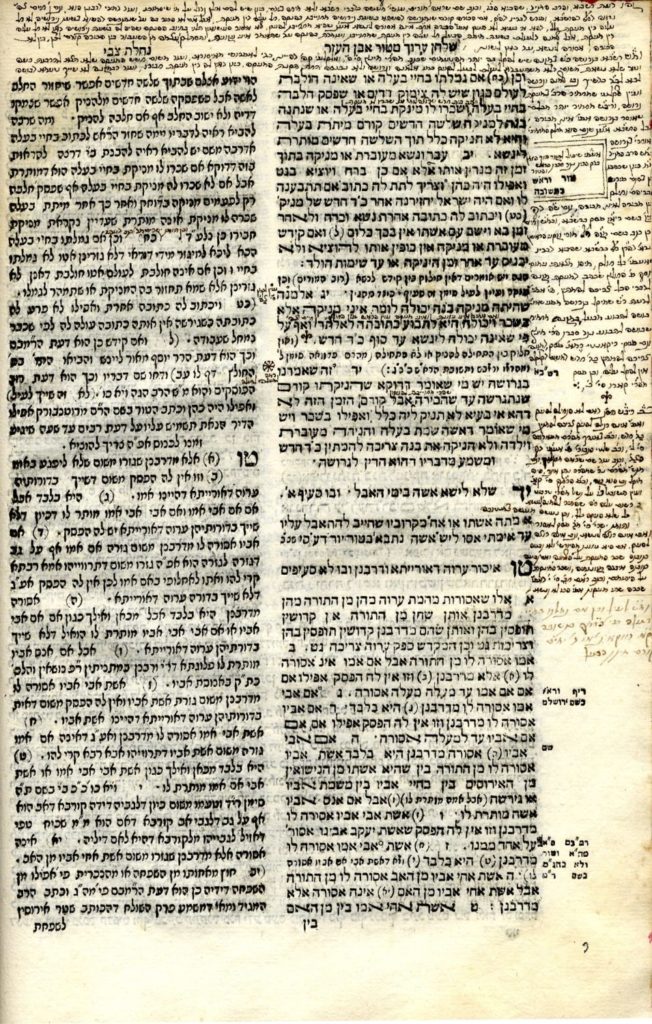
” I heard that he [the Rama” z] had a maggid, and the rabbi, ‘Gur Aryeh, ‘ who composed glosses on the Shulchan Aruch which were printed in Mantua around the text of the Shulchan Aruch, attested that he heard the angel speaking in him.” (The Chid” a).
Hundreds of handwritten glosses and comments – the gaon Rabbi Gur Aryeh of Mantua’s magnum opus on Shulchan Aruch Even HaEzer, in the author’s very own hand.
Rabbi Gur Aryeh wrote his composition around the text of
Nachalat Tzvi , on the sheets of the copy before us (
Nachalat Tzvi , Venice, 1661). Written evidence of this can be found in another copy of
Nachalat Tzvi , found in Machon Ben Tzvi, with Rabbi Gur Aryeh’s glosses copied by Rabbi Yitzchak Lampronti, author of
Pachad Yitzchak , on top of which he wrote: ” These glosses which I copied from another book like this one, are Rabbi Gur Aryeh HaLevi’s, here in Mantua.” (Refer to:
Yeshurun , Volume 19, pp. 861.)
Rabbi Gur Aryeh also signs on the manuscript before us several times under his glosses (see, for example, pages 48b and 49b, where he signs in initials ” הגא” ל” – the youth, Gur Aryeh Levi; and on page 40b, between the lines: ” See my ruling – Gal” i” ).
Provenance of the manuscript: Manuscript collection at the Admo” r Rabbi Menachem Nachum Dov of Sadigura’s library – one of the largest and rarest private libraries of its time. Rabbi Nachum Ber’nyu, who was known as a book and manuscript aficionado, acquired rare and uncommon books and manuscripts, in addition to what he inherited from his predecessors. In this way, he set up Sadigura’s large private libraries. Due to the importance of this manuscript, Rabbi Nachum Ber’nyu signed his name in his own handwriting: ” This book belongs to Nachum Dov Ber Friedman.” This is alongside the usual stamps with which he would stamp his books: ‘HaAryeh, ‘ with his name in Hebrew and in a foreign language; the ‘Kinyan Kaspi’ stamp; and with the red sticker marked ‘Library of Rabbi Nachum Dov Friedman of Sadigura.’ (For more extensive coverage of the rabbi’s library, refer to
Kovetz Mevinei Amudi – in the article by Rabbi Zusha Dinkles: ‘Comprehensive Historic Coverage of Rabbi Nachum Ber’nyu ztzuk” l’s Library’).
The gaon and kabbalist Rabbi Gur Aryeh HaLevi Finzi [d. 1697,
Otzar HaRabbanim 4370] was one of the well-known rabbis of Mantua in the 17th century, and one of the leading Italian sages of his generation. He corresponded with the sages of his generation and dozens of responsa to and from him are printed in their books:
Shu” t Divrei Shmuel (simanim: 97, 106-123, 132-133, 141-144, 153-155, 161-169, 172-174, 210-211, 217-220);
Shu” t HaRama” z (Yoreh Deah siman 2; Even HaEzer siman 1);
Shu” t HaRaba” ch ;
Pachad Yitzchak and others. He also left his mark on Kabbalistic wisdom; he left behind prayers, secrets and intentions, in manuscript. His greatness in the hidden Torah can be gleaned from what the Chid” a wrote about him in his book
Shem HaGedolim (Gedolim, 40, in the entry on Rabbi Moshe Zacut – the Rama” z): ” I heard that he [the Rama” z] had a maggid, and Rabbi Gur Aryeh, who wrote glosses on the Shulchan Aruch which were printed in Mantua around the text of the Shulchan Aruch, attested that he heard the angel speaking in him.” The Chid” a mentions him again in his book, in a special entry dedicated to him (Gedolim, 3): ”
Gur Aryeh . Glosses on the entire Shulchan Aruch printed in Mantua around the text of the Shulchan Aruch. They are by Rabbi Gur Aryeh HaLevi, one of the rabbis of Mantua in the Rama” z’s time.” The manuscript before us was printed posthumously, by his disciple Rabbi Avraham Yedidyah of Basel, and by his nephew, Rabbi Gur Aryeh son of Rabbi Binyamin HaLevi Finzi, around the text of the Shulchan Aruch (Mantua, 1722-1723).
Refer to the Hebrew catalog text for a biography of the Admo” r Rabbi Menachem Nachum Dov of Sadigura.
Specifications:
Nachalat Tzvi by Rabbi Tzvi HaKohen Katz. Venice, 1661. Only edition. [2], 134 leaves, 28 cm. Fully complete, with the leaves of approbations at the beginning, and the table of errata at the end.
Manuscript: There are hundreds and thousands of lines of glosses and novellae in the book’s margins, from siman 1 through siman 115. (Apparently from there on Rabbi Gur Aryeh wrote his glosses as a book in their own right). Italian script. The handwriting before us was compared and found identical to other handwriting by Rabbi Gur Aryeh HaLevi. A comparison has not been made between the manuscript and the printed book to see if it was indeed all printed.
Fine condition. Aging stains. Minimal restored worming perforations. Light restoration to the margins of the title page without damage to text. Old binding, preserved and elegant. Isolated cropped glosses.
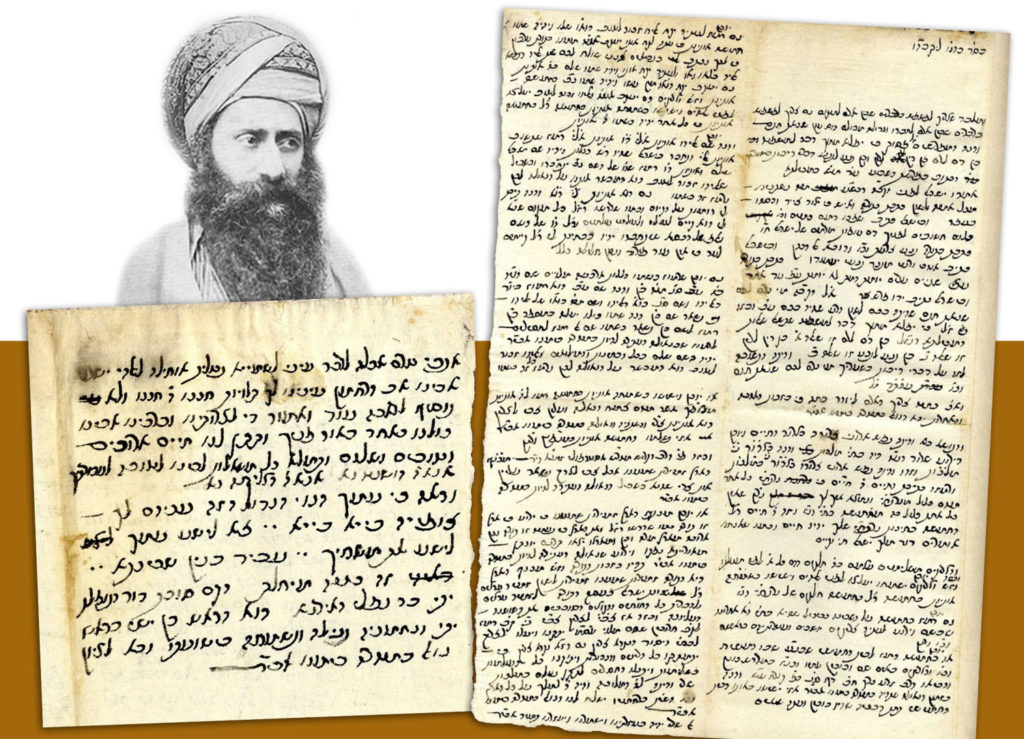
Early sermon handwritten by Rabbeinu Yosef Chaim of Baval, author of Ben Ish Chai . [1840?]
Clear, simple writing on a large leaf written on both sides.
The sermon was apparently given on 7 Elul 1860, a full year after his father’s, Rabbi Moshe Chaim, rabbi of Baghdad’s passing. As is known, immediately after his father’s passing, when he was just 25 years old, he began to lead the community, so this sermon before us is one of his first. The sermon was printed with many changes, in Neveh Shalom Part 1, sermon 2.
“Ana, Hash-m, Hoshiyah Na, Ana, Hash-m, Hatzlichah Na, and see that this large nation looks to You. Biya, biya (- supplications: See, see) go out to save your people, to save your anointed …”
At the beginning of the sermon, there is a passage on caution from baseless hatred, and then it continues at length about the topic of redemption. Aside from the eulogy for his father, there is a extensive sermon about the topic of joy, in which he cites the Zohar , Rabbi Shimshon of Ostropol and others.
Refer to the Hebrew catalog text for a brief biography of Rabbi Yosef Chaim of Baghdad .
[1] large leaf paper. It is known that most of Rabbeinu the author of Ben Ish Chai ‘s writings were written on small leaves, and before us is a large leaf from the beginning of his career …….
32×22 cm.
Placed in a magnificent new semi-leather binding. Very fine condition.
Pay Attention: VAT should be added to the commission for foreign residents as well.
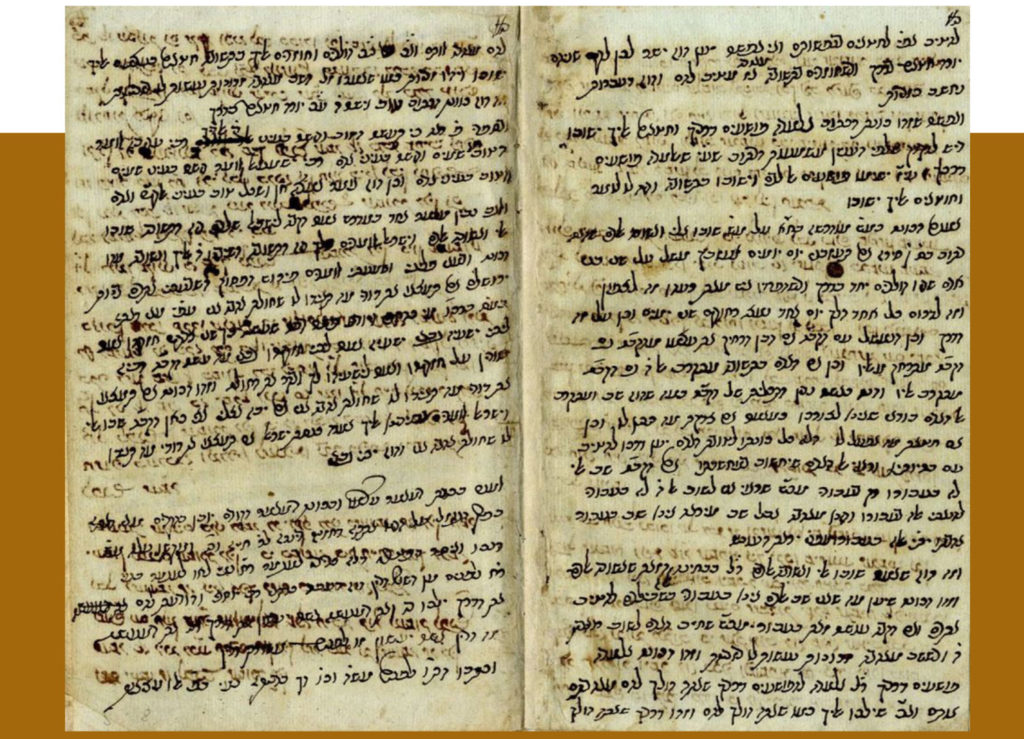
Compilation of sermons and novellae handwritten by the gaon and kabbalist Rabbi Rephael Yeshayah Azoulay, firstborn son of the Chid”a and rabbi of Ancona. To the best of our knowledge, this manuscript has never been printed .
General details of the manuscript: Introduction, sermon for Shabbat Shuvah – including mention of his father, the Chid”a; special prayer for the high holidays composed by Rabbi Rephael; words of rebuke regarding desecration of Shabbat and immodest behavior.
Rabbi Rephael Azoulay [1743-1826] was born in Jerusalem to his father, the Chid”a. He studied under his great father and was considered one of the sages of Jerusalem. When he left his service with the rabbinate of Ancona, the leaders of the community requested via the Chid”a that his son Rabbi Rephael Yeshayah be appointed chief rabbi. Indeed, in 1788 Rabbi Rephael was appointed rabbi of Ancona and served until his passing in 1826. The fact that he lived exactly 83 years, as did his father, has been discussed. In his books, the Chid”a cites many Torah thoughts in his son Rabbi Rephael’s name, and he also cited two halachic responsa from him, as well as many Torah novellae. Each time the Chid”a mentions his son, he uses exalted honorifics: “My precious son, ” “My kindred spirit, ” “The complete sage, ” “The excellent dayan, ” and the like. Rabbi Rephael Yeshayah was known to be ill, and this is mentioned in the letters between father and son. In 1796, his illness became worse, and his father wrote him that in his great distress, he himself has become ill. However, he also wrote to him that no evil would befall him and that he prayed for him in tears. Indeed, he lived another thirty years after this illness. Responsa from him are printed in his father’s books Chaim Sha’al, Yosef Ometz, Pnei David, Mar’it HaAyin. [See more about him in Benayahu’s book on the Chid”a, pp. 476-487.]
[12] leaves. Approximately 13×19 cm. High-quality paper. Oriental script. Fine condition. Several ink smudges and ink perforations. Professional restoration to the leaves’ margins. Simple binding.
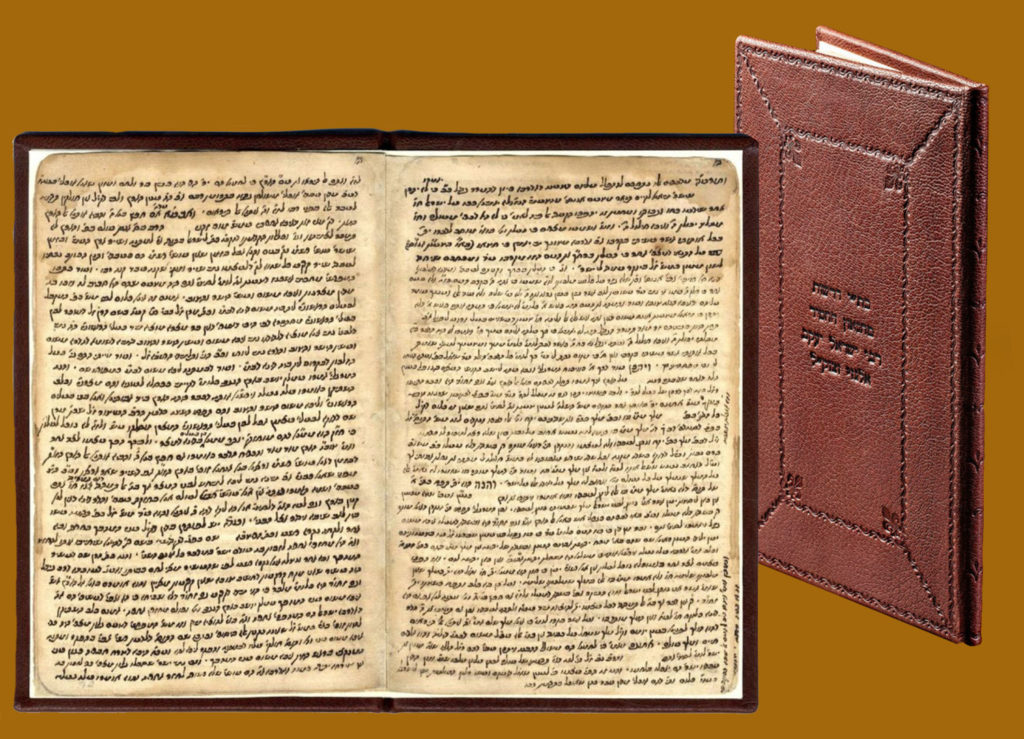
Lengthy sermon covering ten leaves, densely written in the clear hand of Kabbalist and Rishon LeTziyon Rabbi Ya’akov Yisrael Algazi. Jerusalem, 1743. Unprinted, to the best of our knowledge.
At the top of the manuscript, there is a dated title, also in his hand: “Sermon I arranged to deliver for the Jerusalem community, parashat Shelach Lecha 1743.” The sermon begins with the verse “The Land is very very good … but do not rebel against Hash-m.” Rabbi Ya’akov Yisrael praises the land of Israel extensively, as well as the holy city of Jerusalem, and elucidates the transgression of the spies in three ways, one of which is according to the Zohar . Rabbi Algazi concludes his sermon with a prayer in Aramaic for the removal of the Ishmaelites from the Temple Mount: “אנו לי-ה ולי-ה עינינו יתובי יתבין צווחין כי כרוכיא עד מתי לעדה עניה סוערה בהר ובשפלה… עד מתי ייתון בני עממיא לשלם אל מקום המזבח זה מקום המקדש…”
Rabbi Ya’akov Algazi [1680-1716], was a rabbi in Izmir, and one of the leading sages and Kabbalists of Jerusalem. He studied in the Beit-El Kabbalists’ yeshivah and was one of its heads. His teachers included Rabbi Chaim Abulafiah (author of Etz Chaim ) and Rabbi Yitzchak HaKohen Rapoport (author of Batei Kehunah ). He served as rosh yeshivah of Neveh Shalom Brit Avraham in which leading sages of Jerusalem studied, and was a member of Rabbi Eliezer Nachum’s Beit Din. The Chid”a eulogized him. He served as Rishon LeTziyon from 1755 until his passing, and his son the Mahari”t succeeded him. He authored many books, including Shalmei Tzibbur , Ne’ot Ya’akov , Ma’aneh Lashon , Ar’a D’Rabbanan , Kehillot Ya’akov , Maggid Devarav L’Ya’akov .
[10] pp. 10×16 cm. Dense semi-kolmus script with the addition of glosses and marks in the margins of the leaves.
Fine condition. Stains. Professional restoration of the margins. New leather binding.
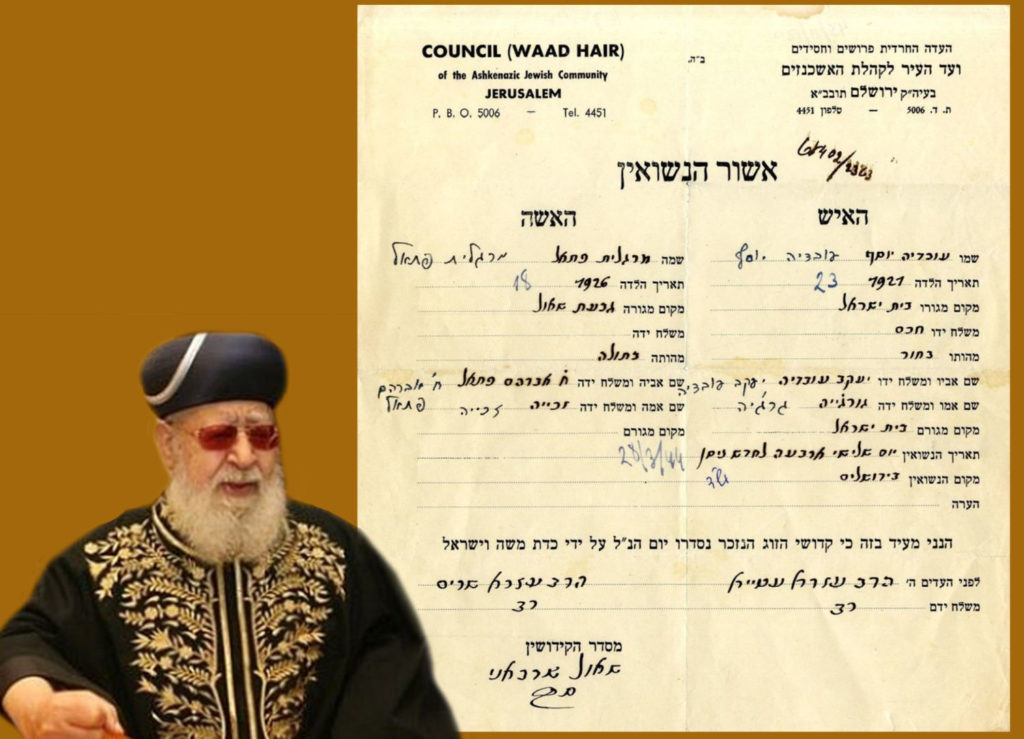
Official Edah Chareidit of Jerusalem marriage certificate for the wedding of the future leader of Sephardic Jewry – the Rishon LeTziyon, Rabbi Ovadiah Yosef, to Rabbanit Margalit. Jerusalem, 1944. Historic document.
This document bears important historic details about the bride and groom: their place of residence, the date and location of their wedding, and more.
Inscribed on the line for the groom’s occupation is: “Sage”! The witnesses to the marriage were his teachers: Chacham Ezra Attiyah and Rabbi Ezra Sarim. The officiating rabbi was Kabbalist Chacham Shaul Sharabani. This document bears signatures of all three sages, among the rabbinic leaders of the generation.
This marriage produced five sons “as tall as cedars, ” illuminating the world with their Torah: the gaon Rabbi Ya’akov Yosef, ztz”l, and, may they be distinguished for long life, the gaon Rabbi Avraham Yosef, rabbi of Holon, the gaon Rabbi Yitzchak Yosef, chief rabbi of Israel, the gaon Rabbi David Yosef, rosh kollel of Yichveh Da’at and member of Shas’s Council of Torah Sages; and the gaon Rabbi Moshe Yosef, head of Bada”tz Beit Yosef.
It is appropriate here to relate an event connected to three of the personalities who appear on the document before us, an event that influenced, albeit indirectly, the entire Jewish people! Rabbi Ovadiah’s father, R’ Ya’akov Ovadiah (who appears in this document on line 12), was an honest man, owner of a convenience store, who worked hard to support his family. When it became too difficult for him to continue the work by himself, he called his son, the youth Ovadiah, and said, “Until now you studied at yeshivah, from now on you are to help support the family.” The youth Ovadiah (who appears in this document on line 7), well-practiced in honoring his parents, parted from the yeshivah with tears and a heavy heart, and went to help his father at the store. The next morning, the rosh yeshivah, Chacham Ezra Attiyah (who appears in this document on line 19), presented himself at the store, removed his rabbinic robe and rolled up his sleeves. To the astonishment of R’ Ya’akov Ovadiah and his many customers, Chacham Attiyah announced: “From now on I will come to this store daily to help out, and the youth Ovadiah, who I am confident will become a great rabbinic leader, will return to his study at the yeshivah.” R’ Ya’akov Ovadiah was convinced that Chacham Attiyah was serious in his intentions, and sent his son back to yeshivah. The Jewish people merited this rabbinic leader, and the
Yabia Omer and
Yichveh Da’at series of books, which hold a prominent place in Torah Literature.
[1] leaf official paper, 25 cm. Fine condition. Aging stains. Fold marks. Tiny tears in the margins and in the folds, without lack or damage.
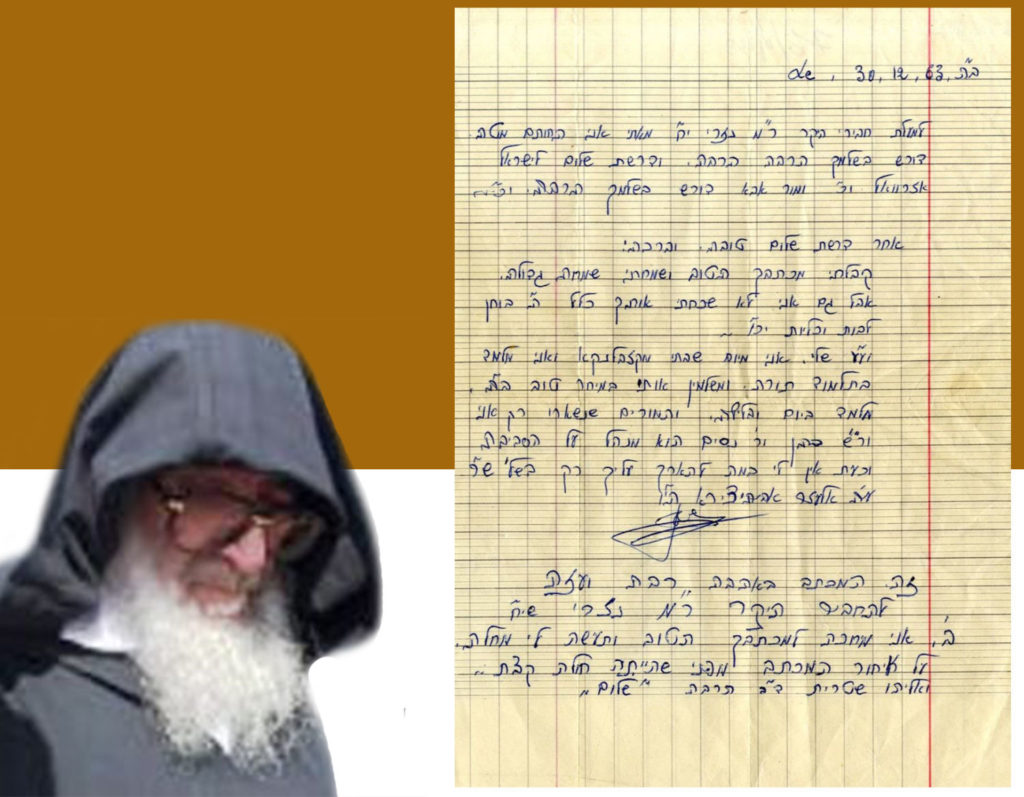
Extraordinarily rare letter from the Admo”r Rabbi Elazar Abuchatzeira “Baba Elazar, ” while a 15-year-old youth in Tafilalt, Morocco, [1963]. There are no other letters known from his adulthood, and certainly not from his youth.
The letter before us opens a small crevice into the inner workings of the Kabbalist, possibly the most mysterious active in recent generations. He almost never wrote letters, was almost never seen in public, even his face was almost never exposed; it was consistently covered with a kind of pointed hat which covered his entire face. Even when he left his home to go to the study hall, he was not exposed to the public. There was a special underground tunnel leading from his home to the study hall. In the letter before us, despite the rabbi’s young age, the royal and sanctified manner of the Abuchatzeira family can be identified; the name itself inspires chills of sanctity. The rabbi, who was orphaned of his mother, writes a letter at length and very openly to his good friend Rabbi M. Neziri about what is happening with him. He also sends regards from “Mor Abba” – none other than the ‘Baba Meir.’
Rabbi Elazar writes, inter alia, in his letter, that he has recently returned from Casablanca. Rabbi Elazar studied at the Chaba”d yeshivah in Casablanca. His brother, may he be distinguished for long life, Rabbi David Abuchatzeira, attests that Rabbi Elazar already knew the entire Tanya by heart at the time. This letter demonstrates that at the age of 15 he already returned from Casablanca and went back to Tafilalt as a teacher in the Talmud Torah. This shows that at the age of 15 he already knew the entire Tanya by heart!
Rabbi Elazar Abuchatzeira, known as ‘Baba Elazar’ [1948-2011] was a scion of holy ancestors – son of ‘Baba Meir’; grandson of ‘Baba Sali’ and so forth. He was named after the Tana Rabi Elazar son of Rabbi Shimon bar Yochai because before he was born, the Baba Sali saw Rabbi Shimon bar Yochai in a night vision. At his circumcision, the Baba Sali read the verse “ע’ין ל’א ר’אתה א’לוקים ז’ולתך” [“an eye has not seen the L-rd but for you”] whose first letters spell out his name, regarding him. This illustrative expression demonstrates this newborn’s value and soul-root. From an extremely young age, he was mainly known for guarding his eyes, and there was a special underground tunnel leading from his home to the study hall. In the last decades of his life, he only went out into the street a few times. Baba Elazar received masses of people each day, but few were privileged to see the radiance of his face. There are many stories of the tremendous power of his blessings and counsel, and masses flocked to him to receive his advice and blessing. He was murdered in 2011 by a man who came to receive his blessing, drew a knife, stabbed him, and killed him. At the end of the shivah, the chief rabbi of Israel, Rabbi Shlomo Moshe Amar, wrote a lamentation in his memory in the style of the Tisha B’Av lamentations.
[1] notebook leaf graph paper. 22 cm. Entirely handwritten and signed by the rabbi. Fine condition. Fold marks and creases.
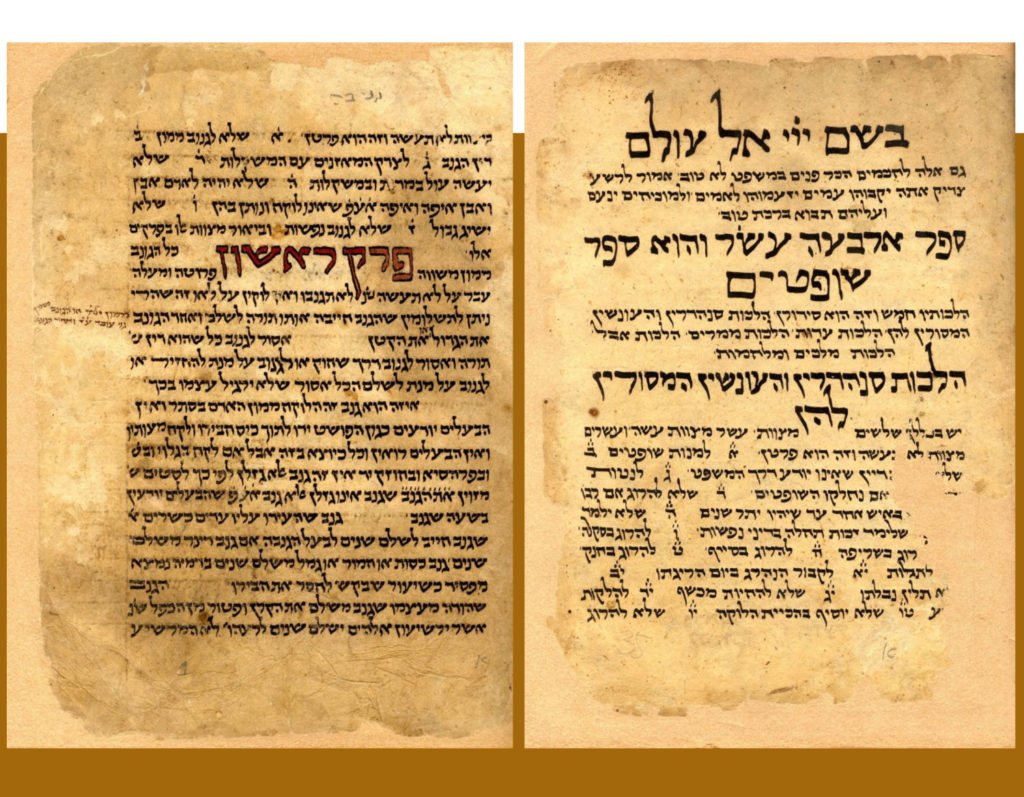
Manuscript – Mishneh Torah L’Ramba”m , bundle of leaves from the books of Mishneh Torah , primarily from the books Shoftim and Nezikin . Many differences from the printed version. Yemen, 14th century (approximately 100 years before the invention of the printing press).
In the manuscript before us, written, as mentioned, before the advent of the printing press, there are many differences in comparison to the version printed in current editions of the Ramba”m. Differences appear on almost every one of the leaves! Many of the differences are linguistic, not involving actual differences in the halachah. Yet, they can be used to resolve difficulties and contradictions in the Ramba”m’s words. Occasionally, entire edifices built on a single word in the Ramba”m by the Later Authorities collapse due to the version in this manuscript. There are also changes in the numbering of the halachahs, for example, Sefer Shoftim, Hilchot Mamrim, Chapter 9, contains 14 halachahs, and the version before us contains 17 halachahs.
The Ramba”m’s original manuscript of Mishneh Torah survives in about 20 draft-leaves, found in the Cairo Geniza. The text of Mishneh Torah underwent many changes and errors over the years, both in the text of the halachahs, and in their divisions. The source of these changes is copying errors set in print, edits by copyists who “corrected” to what they saw as appropriate in their opinions, and the Christian censor, who changed the original text. In addition to these, the Ramba”m himself corrected the text several times in the copy of this book in his possession. As such, the version extant in the prevalent prints over the generations is not the conclusive, precise text produced by the Ramba”m. Scholars use ancient manuscripts and remnants of ancient prints to clarify the precise text. Rabbi Yosef Kapach maintains that the Yemenite manuscripts, such as the one before us, are the true and correct version.
[104] p, 20×27 cm. Ink on thick, high-quality dark paper. Fluent Yemenite scribal script. The chapter headings are highlighted in red ink.
Moderate-fine condition. Minimal aging stains. Professional completion of the margins, with damage to text on individual leaves. New leather binding.
Pay Attention: VAT should be added to the commission for foreign residents as well.
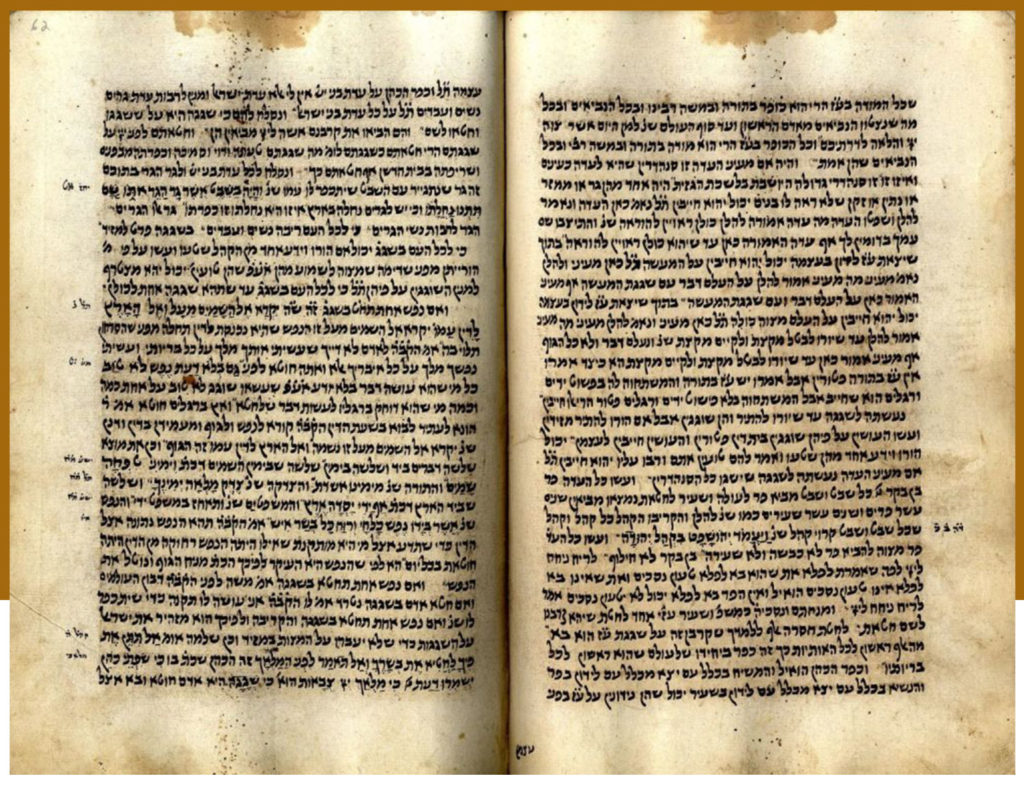
Midrash HaGadol on Sefer Bamidbar by Rabbi David ben Amram HaAdeni. Yemen, 1643.
Complete volume consisting of the words of Midrash HaGadol on Sefer Bamidbar. Ancient glosses in the leaf margins. Vowelized hymn at the beginning of each weekly portion.
Copyist’s colophon at the end: ” Chaim Ben Avraham Alachmar … completed on Sunday the 21st of the month of Iyar, 1643. Copied from a proofread book as much as possible.”
Midrash HaGadol is an ancient composition on the Torah authored by Rabbi David ben Amram HaAdeni – from the city Aden, in Yemen. He lived in the early 14th century. His work is based on many sources in Chaza”l and the geonim, including works that were later lost or survived only partially, such as the Mechilta, the Safra [Torat Kohanim] and other early midrashim. Several midrashim that appear in it are unknown from any other source. There is a hymn at the beginning of each weekly portion. Midrash HaGadol was well-known and widespread among the Jews of Yemen, many Yemenite sages were occupied with it and even wrote several commentaries on it.
[155] leaves. 30.5 cm. Fine condition. Tears in the first and last leaves. Stains. Old binding.
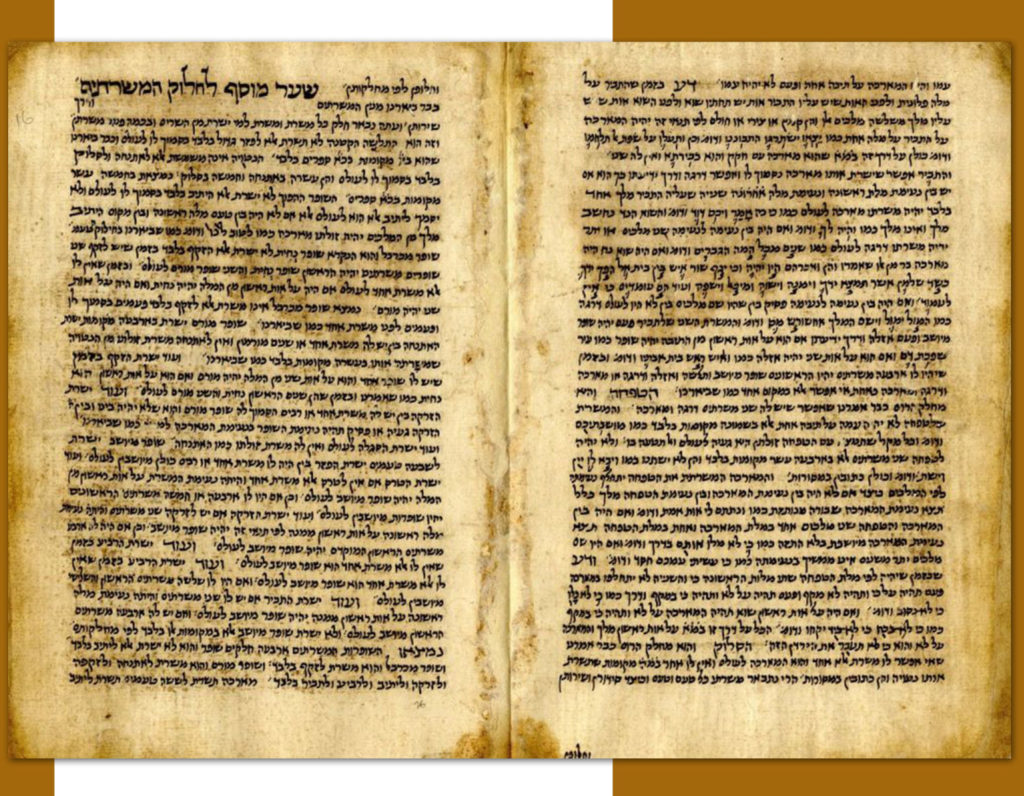
Tijan. The basic composition in grammar of Lashon HaKodesh from an anonymous Yemenite sage. Yemen, 16th century.
Composition divided into sections: the section on letter exchanges [חילוף האותיות זה בזה], the section on word construction and word combinations [ידיעת בנין התיבות וצירופם], the section on kings’ names and their forms [שער שמות המלכים וצורתם], the section on shva [ידיעת השוא] and more.
Beautiful scribal script. [33] leaves, approximately 30 cm. Lacking individual leaves at the beginning.
Fine condition. Aging stains. Professional margin completions. Professionally restored worming perforations.
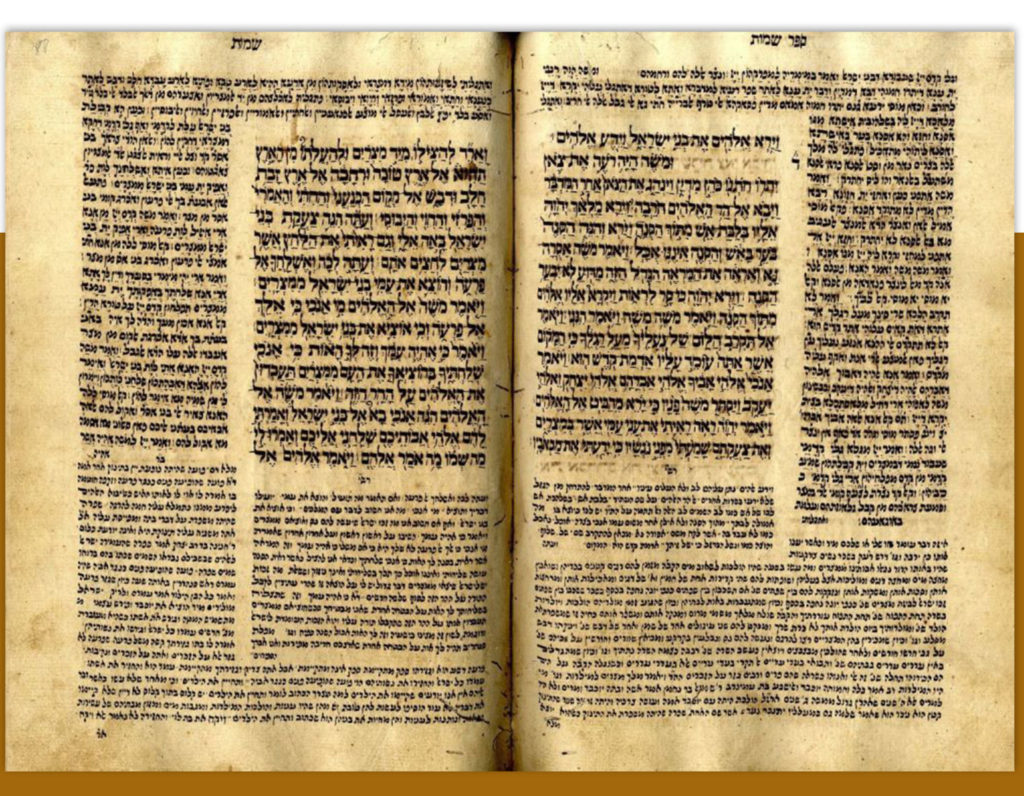
Tāj (Bereishit-Shemot). Including the Torah with vowelization and cantillation, Targum Onkelos, Rash” i’s commentary and Yalkut Midrashim.
Inscribed at the beginning of the manuscript: “I will start at Sefer Bereishit with the help of E-l, Creator of the world.”
[154] leaves, paper. 32×21 cm. Beautiful and orderly Yemenite script.
Moderate condition. Stains. Worming perforations. Minimal tears without lack in the text. Cardboard binding.
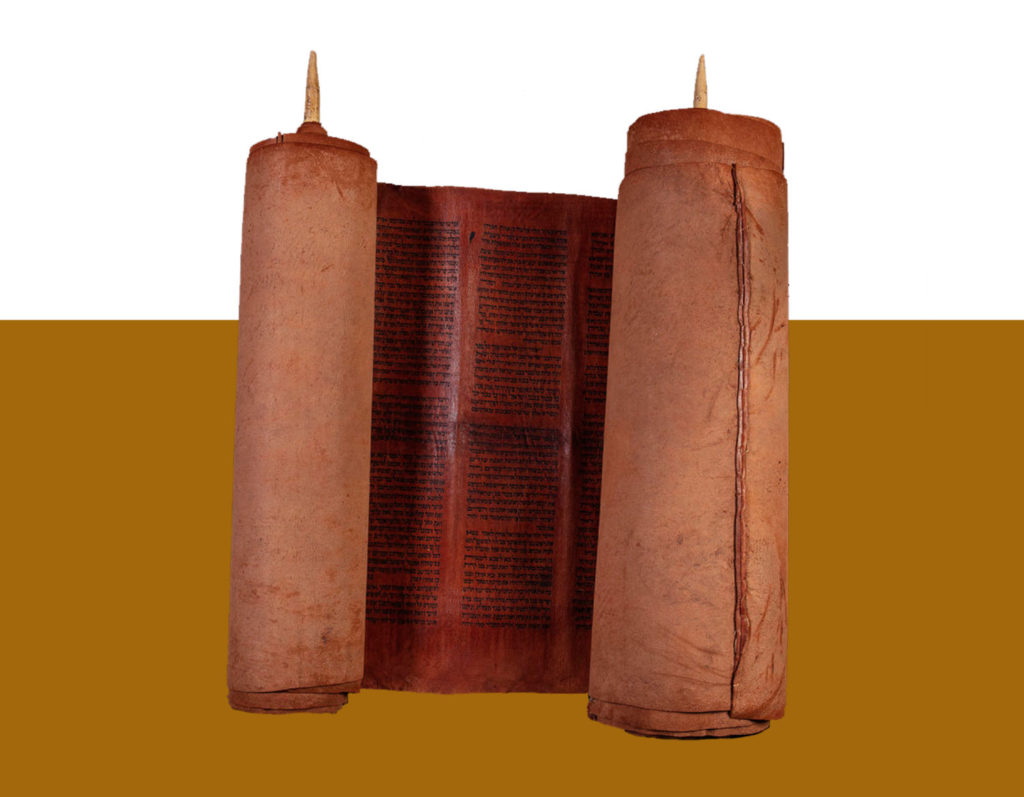
Complete Torah scroll written in ink on gevil. Yemen, 19th century.
Torah scroll handwritten in expert scribal script; uniform script along its entire length. Red gevil from a large domestic animal, per the Yemenite custom. The writing was done on the outside of the skin, resulting in its exceptional color: reddish-brown. The sheets and the writing appear uniform along the entire scroll. There are also corrections throughout the scroll attesting to the scroll’s use over the years and its regular maintenance.
Sheet height: 50 cm, script height: 44 cm, 50 lines. Fine condition. The kashrut of the scrolls has not been examined.